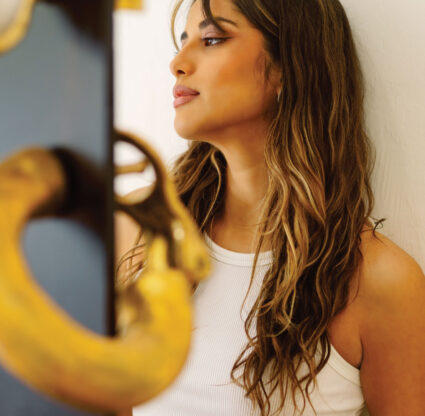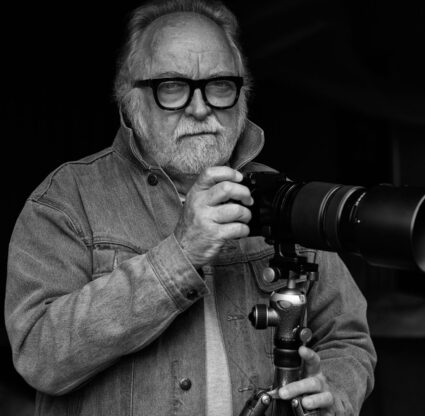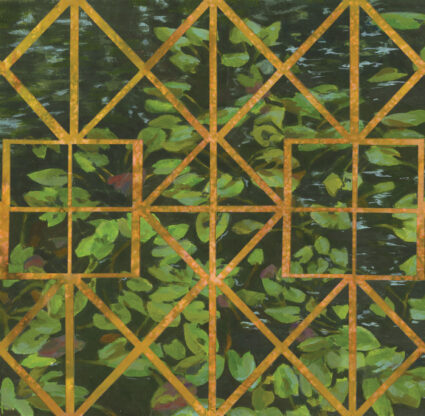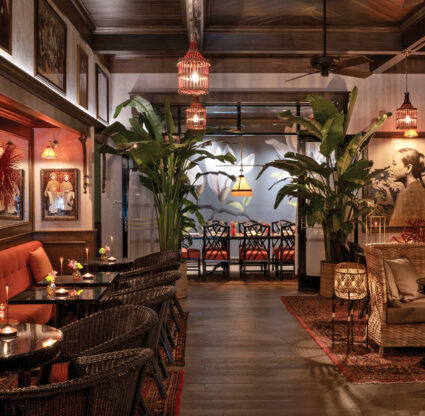Marcus Jansen looks up in awe. Splashes of fireman yellow reflect in his eyes, pulling dominant hues from the assortment of Purvis Young paintings collaged into murals within the Bob Rauschenberg Gallery at Florida SouthWestern State College in Fort Myers. There is an undeniable kinship between Marcus, a respected painter from New York City’s Bronx borough, and Purvis, the lauded, Miami-bred, self-taught expressionist. Though the two men never met, their artistic agendas mirror one another, so much so that a 2020 exhibit in Fort Lauderdale, Divided We Fall, emphasized the parallels in their practices. Marcus Jansen is the perfect guy to show me around the Purvis Young: Honey in the Sky exhibit, running through July 13.
The exhibit showcases more than 75 original paintings spanning more than 40 years of Purvis’ career. Among the gritty, pastel-tinged works, you’ll see Purvis’ knack for gestural paintings splashed onto pieces of reclaimed wood, canvas, burlap, cardboard and paper, with elements from African folk art and European masters, such as Vincent van Gogh and El Greco. Symbols (wild horses for freedom, cages for oppression, angels for hope and boats for migration) recur throughout the canvases, documenting the cacophony of urban life and strife Purvis saw around him in Miami. Most of the paintings are unnamed, so the viewer is free to draw their own conclusions. “It’s a big part of what good art provides us—something that stimulates your intellectual capacity,” Marcus says. “It makes each individual feel or see something differently because you bring something [of yourself] to the table.”
Marcus discovered the late artist’s work around 2005 through a mutual friend and now owns five of Purvis’ pieces. The two come from different generations and places, but the artists’ work is innately similar. Both explore themes of class, race, humanity and spirituality with vivid colors. Growing up in the inner city informed the Afro-Caribbean artists’ perspectives. Where Marcus’ contemporary depictions of colonial soldiers explore the deeply rooted issues of capitalism, Purvis’ abstract expressionist paintings serve as a lifetime thesis on the Black American experience.
Swells of sorrow, awe, nostalgia and joy roll through Marcus as he traces the visual narrative, which includes images of black, red and yellow figures depicted behind bars; kids’ faces floating in the sky like angels; and Black and white figures dancing in harmony. “I think he had deep human concerns, which is the same in mine—the underlying tone in my work is human concern,” Marcus says. “You’re really looking at his soul when you look at his work.”
Marcus is drawn to a simple pink and yellow landscape framed by what looks to be a fractured piece of wood paneling. Purvis’ use of found materials reminds us of the gallery’s namesake, Robert Rauschenberg, who would also walk around looking for pieces of his environment to incorporate into collages. Inside the thick frame, Purvis connected three strips of canvas to paint a high-rise building with his signature squiggle figures lining the street and roof above—a testament to his raw, innocent style. While the figures may look childlike in technique, each curved body is meticulously painted with one brushstroke.
For inspiration, Purvis looked to issues within his community, as well as global matters past and present. “We were both critiquing and commenting on the system, on an oppressive system for the Black and Brown people in America, which is not overly shown in the visual arts.”
Purvis lived in the mostly Black, underserved community of Overtown, just south of Miami’s Wynwood area, from his birth in 1943 until he died in 2010. “[Overtown] was a rough area, but he was able to produce something so pure in that environment,” Marcus says. Purvis taught himself to paint and often incorporated found materials, like wood and carpet as frames, fabric as canvas, and leftover paint gifted to him by local firefighters (the source of many of Purvis’ yellow-toned works).
Looking at his paintings, you feel the Miami heat and hear the traffic. It’s as if you’re with him on the street, documenting the strife, celebrating the people and dreaming of a better life. Purvis would use proceeds from his works—which sold for $20 in the ’70s—to help his neighbors. The love for his hometown comes through in every quivering, calligraphic stroke. “That purity is what people are paying attention to,” Marcus says.
While Purvis’ works are now shown in prestigious institutions, from The Metropolitan Museum of Art in New York City to the Smithsonian American Art Museum in Washington, D.C., the artist spent much of his life struggling to make ends meet. “[His work] was often labeled as primitive art, outsider art,” Marcus says. “I never saw anything like that; it was always very much insider, very much contemporary art. It’s just a matter of how you label things, right? I never liked these labels anyways.” Marcus revels in the expanded inclusivity that’s emerged since the Black Lives Matter movement in 2020 helped shine a light on artists of color. Inclusion, Marcus explains, is not a matter of reinvention but rather recognition. “That’s exactly what’s been missing, the idea that he’s included [in the world of fine art]. That goes for many Black and Brown painters over the decades—we want to be included. It’s not so much about changing anything, but it’s a matter of saying, ‘Hey, this work has a value stamp on it,’” he says.
Like Purvis, Marcus started his career selling works on street corners in his city, stacking canvases against the buildings in hopes a buyer would bite. Marcus points to the arrangement of Purvis’ works within the Bob Rauschenberg Gallery, cleverly cluttered onto the walls as Purvis would have done on the outside of abandoned buildings throughout Overtown. “This is really inspirational,” Marcus says, stepping closer to the expressive display. “You feel freedom when you’re standing here. He was completely free and direct.”




